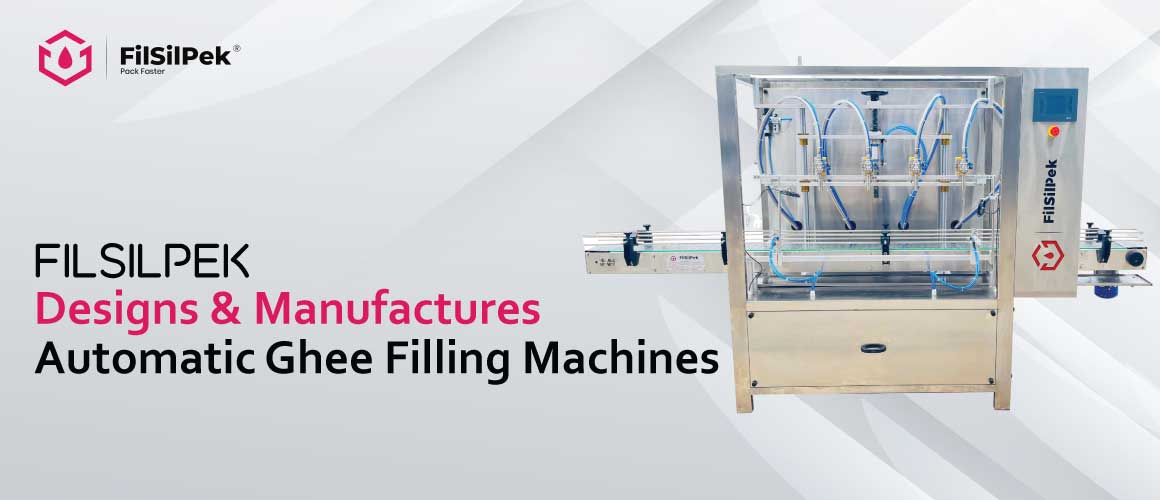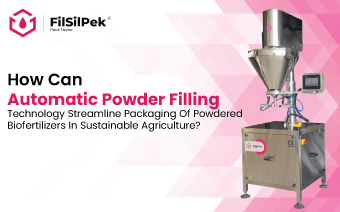Disadvantages of Manual Ghee Filling Machine
Have you ever wondered what goes into that beautifully packed jar of ghee, or clarified butter, that graces your kitchen shelf? The process of ghee manufacturing is a meticulous art, and one of the critical stages is ghee filling.
In this article, we will discuss the crucial function of ghee filling, focusing on the disadvantages of manual ghee filling machines, and why automatic ghee filling machines have emerged as the saviors of this time-honored tradition.
Let’s check that out quickly.
Importance of Ghee Filling in Ghee Manufacturing Business
Ghee, a revered culinary ingredient, owes its exceptional quality to the precision of the ghee filling process within the manufacturing business. Proper filling techniques are vital for preserving ghee’s purity, flavor, and shelf life.
Additionally, ghee is often used in small quantities, making accuracy in filling essential to satisfy customers’ expectations. Inconsistent filling can lead to dissatisfaction among consumers who depend on accurate recipe measurements. The significance of ghee filling extends to production efficiency, as manual methods can slow down the manufacturing process.
Disadvantages of Manual Ghee Filling Machine
It may cause Inconsistency in Filling: Manual ghee filling is prone to inconsistencies in the quantity of ghee filled into each container. This inconsistency can lead to customer dissatisfaction and affect product quality.
It is a Labor-Intensive Process: Filling ghee containers manually is labor-intensive and time-consuming. Skilled labor is required to ensure precision in filling, and the process is subject to fatigue and human error.
It has an Increased Risk of Contamination: Manual filling exposes the ghee to a higher risk of contamination from external sources, as it involves more human handling, potentially compromising the product’s hygiene and purity.
It creates Bottlenecks in Production: Manual ghee filling is often a bottleneck in the production process. The slow and tedious nature of this method limits the production capacity and increases the overall manufacturing time.
Automatic vs. Manual Ghee Filling Machine: A Comparative Analysis
Ghee, with its rich flavor and numerous health benefits, holds a special place in the culinary world, particularly in South Asia. The process of filling ghee containers is a critical aspect of ghee production, and the method chosen can significantly impact the quality, efficiency, and overall success of a ghee manufacturing business.
Let’s explore the differences between automatic and manual ghee filling machines to better understand the pros and cons of each approach.
Precision and Consistency
Automatic Ghee Filling: Automatic ghee filling machines are designed for precision. They use advanced measuring systems to dispense the exact quantity of ghee into each container, ensuring consistency in every pack. This precision is essential for maintaining product quality and meeting customer expectations.
Manual Ghee Filling: Manual filling, while skill-dependent, is prone to inconsistencies. Human error and fatigue can result in variations in the amount of ghee filled into containers, which may lead to customer dissatisfaction and quality control issues.
Efficiency and Speed
Automatic Ghee Filling: Automatic machines are known for their speed and efficiency. They can fill ghee containers at a much faster rate than manual methods. This improved efficiency is particularly valuable in meeting high demand and reducing production time.
Manual Ghee Filling: Manual filling is a labor-intensive process that often acts as a bottleneck in the production line. It can slow down the entire manufacturing process, limiting production capacity and increasing costs.
Labor Dependency
Automatic Ghee Filling: Automatic machines reduce the need for skilled labor. They can be operated with minimal human intervention, which translates to cost savings and decreased chances of human error.
Manual Ghee Filling: Manual filling relies heavily on skilled labor to ensure precision. This dependency on human skills can be both costly and risky in terms of product consistency.
Hygiene and Contamination Control
Automatic Ghee Filling: Automatic machines minimize human contact with the ghee, reducing the risk of contamination. They are designed with strict hygiene and safety standards in mind, making them a more reliable choice for maintaining product purity.
Manual Ghee Filling: Manual filling involves more human handling, which increases the risk of contamination from external sources. Maintaining the same level of hygiene can be challenging with this method.
While manual ghee filling machine and methods have their place in tradition and smaller-scale operations, automatic ghee filling machines offer significant advantages in terms of precision, speed, efficiency, reduced labor dependency, and improved hygiene. As the demand for high-quality ghee continues to grow, ghee manufacturing businesses are increasingly turning to automation to maintain product consistency and meet market demands efficiently.
How Automatic Ghee Filling Machine Works?
Automatic ghee filling machines are sophisticated pieces of equipment designed to streamline the ghee filling process in ghee manufacturing facilities. These machines use advanced technology and mechanisms to ensure precise and efficient filling. Here’s a simplified explanation of how an automatic ghee filling machine works:
- Ghee Reservoir: The process begins with a reservoir that stores the prepared ghee. This reservoir can vary in size depending on the production requirements of the ghee manufacturer.
- Conveyor System: Containers, such as jars or bottles, are placed on a conveyor system that transports them to the filling station. The conveyor system can be customized to accommodate various container sizes and shapes.
- Filling Nozzles: At the filling station, there are multiple filling nozzles, each connected to the ghee reservoir. These nozzles are precision-engineered to dispense the exact quantity of ghee into each container. The number of nozzles can vary based on the machine’s capacity.
- Measuring and Control Systems: Automatic ghee filling machines are equipped with precise measuring and control systems. These systems ensure that the correct volume of ghee is dispensed into each container. They use sensors and feedback mechanisms to maintain accuracy.
- Container Positioning: As containers move along the conveyor, they are positioned directly under the filling nozzles. The machine uses sensors or mechanical guides to ensure precise alignment.
- Ghee Dispensing: Once the containers are in position, the filling nozzles dispense the ghee. The nozzles are designed to fill containers quickly and without splattering, minimizing mess and waste.
- Capping and Sealing (Optional): Some automatic ghee filling machines come with integrated capping and sealing mechanisms. After ghee filling is complete, these machines can automatically cap and seal the containers. This is especially beneficial for enhancing product hygiene and streamlining the production process.
- Monitoring and Control: Many modern automatic ghee filling machines are equipped with monitoring and control systems. These systems provide real-time data on the filling process, including the number of containers filled and any deviations from the desired fill volume. Operators can use this data to make adjustments and maintain product quality.
- Conveyor Exit: After filling and, if applicable, capping and sealing, the filled containers are transported away from the filling station on the conveyor. They can then proceed to labeling and packaging processes, completing the production cycle.
Automatic ghee filling machines are designed to operate efficiently, ensuring precision, speed, and consistency in the filling process. These machines not only save time and labor but also contribute to the overall quality and hygiene of the final ghee product. Their automation and advanced control systems have made them invaluable tools for ghee manufacturers seeking to meet the demands of the market efficiently and cost-effectively.
Benefits of Automatic Ghee Filling Machine
Automatic ghee filling machines are designed to streamline the ghee filling process. These machines come equipped with advanced features such as:
Precise Measuring Systems: Automatic machines use precise measuring systems to dispense the exact quantity of ghee into containers.
Conveyor Belts: Conveyor belts or robotic arms are often integrated to transport containers efficiently, ensuring a continuous flow of the filling process.
Automatic Capping and Sealing: Some machines can automatically cap and seal the filled containers, further reducing the need for manual labor.
Data Monitoring: Modern machines provide data monitoring and control features, allowing manufacturers to track production and make real-time adjustments.
Conclusion
While the tradition of making ghee remains deeply rooted in our culture, the disadvantages of manual ghee filling cannot be ignored. The ghee manufacturing industry has recognized the need for innovation and efficiency. Automatic ghee filling machines have emerged as the solution to these challenges, offering precision, speed, and reliability. As technology advances and these machines become more accessible, the production of high-quality ghee is now more efficient and cost-effective than ever. It is a testament to the fusion of tradition and technology in the world of ghee filling, ultimately benefiting both manufacturers and consumers.
In today’s ghee manufacturing business, the automatic ghee filling machine is not just a piece of equipment; it’s a game-changer. So, whether you’re a ghee producer looking to enhance efficiency or a ghee enthusiast seeking the purest quality, the automatic ghee filling machine is the key to a future where tradition meets innovation seamlessly.
So, are you ready to modernize your business with an efficient and effective Automatic Ghee filling machine? Connect with us now or write us at [email protected]
How can automatic powder filling technology streamline packaging of powdered biofertilizers in sustainable agriculture?
The demand for biofertilizers has increased sharply as agriculture moves toward….
What new challenges arise in packaging high-value cosmetic oils extracted from food-grade raw materials, and how do filling machines adapt?
High-value cosmetic oils like argan, almond, jojoba, avocado….
How are D2C edible oil startups using smart filling systems to offer personalized packaging for home delivery?
Direct-to-consumer (D2C) edible oil brands are changing the way households buy and use cooking oils. By cutting….



